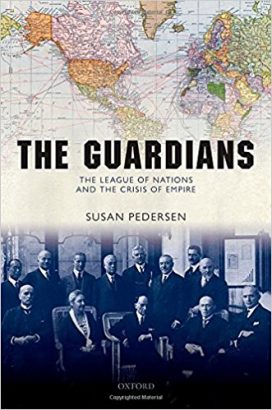A book about the League of Nations, let alone one of its little known subsections, the Permanent Mandates Commission, in the 21st century? Even a reasonably well-informed person might instinctively raise a cynical eyebrow questioning its value. After all, the League’s efforts to manage and contain the ambitions of rival Great Powers had utterly failed to achieve its goal of preventing a recurrence of World War One.
However, the distinguished Columbia University historian Susan Pedersen thought otherwise, and we are fortunate that she did. Combing through countless archives and digesting a vast amount of secondary literature, she has produced an eminently readable, if weighty tome that sheds much light on the momentous developments across the globe between the two world wars. In offering a new interpretation of these events, she reminds us that history unfolds in unexpected ways with unexpected consequences. This results in our contemporary ‘unhappy world of nation states, rich and poor,’ as one endorsement of the book put it. Pederson also reminds us – professional historians and the larger public alike – that history is not just about deep impersonal forces, but also the actions, predilections and foibles of individuals. Indeed, the book profiles a rich cast of characters, from heretofore faceless bureaucrats to South Sea adventurers to agile ‘native’ activists.
The myriad consequences of the carving up of ex-Ottoman Arab lands by the victorious Western powers after World War One and establishment of British and French mandates over the various territories, have long been vital material for historians of the Middle East, Britain and France, not to mention the populations directly affected by them. The chaos spawned by the Arab Spring uprisings in 2011 was merely the latest reminder of the problematic origins of the Middle East state system. One of the many strengths of this book is that these origins are placed in a larger international framework of attempted global governance, that included not only the ‘Class A’ mandates over Iraq, Syria and Lebanon, and Palestine, but the ‘Class B’ mandates – British and French Cameroon, British and French Togo, Tanganyika (Britain), and Rwanda/Burundi (Belgium) – and the ‘Class C’ mandates of Southwest Africa (Republic of South Africa), Western Samoa (New Zealand), New Guinea (Australia), the remote Pacific island of Nairu (British Empire mandate), and the Marshall, Mariana and Caroline Islands, known collectively as Micronesia (Japan). Notably, some of these territories had been German colonies before the war, and Pedersen mines the German foreign ministry archives with great skill to highlight the oft-ignored history of Germany’s efforts (both under the Weimar Republic and the National Socialists) to restore its great-power status in its former territories as well as promote Arab and African claims for independence.
As Pedersen shows, the mandate system was paternalistic in intent, not emancipatory. It began as a project of imperial reconciliation and legitimation, responding to Woodrow Wilson’s insistence on an ‘anti-annexationist peace’ and on the right of self-determination for all peoples. British statesmen led the way in redefining territorial control as a means for the ‘civilized’ world to promote the well-being and development of ‘backward’ areas and peoples, which was defined as ‘a sacred trust of civilization’. As the book chillingly shows, the extant discourse of civilizational hierarchies, which had underpinned dehumanising justifications for slavery, conquest, and exploitation for centuries, shaped the practice of control, particularly in the African mandated territories and New Guinea.
A central innovation of the mandate system was the obligation of the mandatory powers to deliver annual reports to the nine-member Permanent Mandates Commission (PMC) based in Geneva. Despite its inherent tilt towards the interests of the mandate powers, anti-colonial groups in the West and nationalist movements in the mandated territories incessantly petitioned the PMC with its many grievances, opening up imperial rule to ‘an uncontainable wave of scrutiny and “talk”’. By the late 1920s, thanks in part to (aggrieved) Germany’s efforts, the PMC forced the League Council to acknowledge that the mandatory powers were not sovereign in their mandate territories. As such, ‘statehood’ began to become a real option for the indigenous people, and the principle of self-determination was advanced, but not, ironically, due to the international oversight of the PMC but as an alternative to it. Such was the context in which Iraq shed its mandate, while becoming bound to Britain in ways that were advantageous for a small elite but utterly unpalatable to a younger generation of strident Iraqi Arab nationalists.
More broadly, Pedersen argues that the League, best understood as ‘a force field made up of shifting alliances, networks and institutions which a host of actors entered and sought to exploit,’ unintentionally helped bring down European empires thanks to the dynamics of internationalism that had been unleashed. Henceforth (from the close of World War Two), decolonisation and independence would become a nearly universal norm, and states would recalibrate the means by which their various interests could best be served. Of course, the process would have taken much longer had not Britain been bled white by the war and France exposed to its colonial subjects as a second-tier, less than all-powerful power, leaving the US, with its strong anti-colonial and anti-communist instincts alone at the top of the Western heap.
Readers of this publication will take special interest in Pedersen’s treatment of the Palestine Mandate, and some will presumably find portions of it unsettling. The explicit inclusion of the Balfour Declaration’s support for the creation of a Jewish national home in Britain’s responsibilities for Mandated Palestine, a responsibility which included facilitating Jewish immigration and encouraging ‘close settlement by Jews on the land’ was, of course, a crucial moment on the road towards 1948. The author’s statement that neither the Balfour Declaration nor the Mandate explicitly promised the creation of a Jewish national home, let alone a state, but only that Britain would work to create conditions that would allow the Jews to establish that home themselves, is technically correct. While such a distinction can seem like hair-splitting, it also imparts agency to the Zionist movement, for the real challenges lay ahead. Indeed, Pedersen praises the ‘particular genius’ of Chaim Weizmann for recognising that this was enough for the time being, even while implying that the liberal and progressive Zionism – of the interwar years that he represented and which so many found appealing – masked the simpler logic of Ze’ev Jabotinsky’s revisionist Zionism that couldn’t be articulated at the time: namely that the interests of continued Zionist colonisation had to override those of the native population.
Indeed, the inherent tension found in the Mandate charter between the exigencies of promoting conditions for the Jewish national home and the parallel commitment to promoting self-governing institutions for the existing non-Jewish population of Palestine was never resolved. But sympathies in Geneva were with the Zionist side, enabling it to parry the argument that Palestinian Arabs should be accorded the same rights as the Arabs in other mandated territories, whose demands for self-determination were becoming harder to ignore as time went on.
Citing the late J.C. Hurewitz’s statement that the Mandate was ‘framed unmistakably in the Zionist interest,’ Pedersen notes that the Zionist leadership and the PMC shared ‘a common culture and orientation – a common habitus – that made collaboration in parrying Arab demands natural’. This common culture, in her view, included a patronising view of the ‘natives,’ something which is hard to deny, even if it is hard to swallow. So is the fact that ethno-nationalist governments such as Poland and Romania, eager to reduce their Jewish populations, were critical of Britain’s alleged laxness in dealing with Arab unrest in Palestine. The PMC’s lack of support for the 1937 Peel Commission’s recommendation of partition of Palestine, owing to the small size of the territory allocated to the Jews, contributed to Britain’s retreat from the plan, although it certainly wasn’t the dominant factor.
Pedersen’s conclusion that Britain would have abandoned its commitment to the Zionist project years before it ultimately did so (the 1939 White Paper), had it not been for its commitment to the League’s Mandate framework is original, and worthy of consideration. This commitment, she emphasises, stemmed from political pressures being articulated both in the House of Commons and League institutions, particularly the PMC. For example, she shows how the latter’s criticism helped to undermine British High Commissioner for Palestine Chancellor’s plan in 1930 to place severe restrictions on Jewish immigration and land sales, and opened the way to the McDonald letter that insured the large scale immigration from Germany following Adolf Hitler’s ascent to power. It was this wave of immigration that established a critical mass for the Zionist movement, both demographically and economically, that ultimately enabled its institutions to establish the State of Israel in 1948.
Pedersen attributes this crucial pre-war achievement to a combination of factors: the Zionist movement’s superior political skills, the sentiments of the House of Commons, and, in some measure, ‘the political inflexibility and stasis created by the dynamic of competitive internationalisation, and to the Permanent Mandates Commission of the League of Nations’. While not taking issue with this, I would explicitly add to the mix the same level of agency regarding the Arab parties to the conflict, i.e. the internal Arab Palestinian and intra-Arab divisions and lack of social and political cohesion, that she ascribes to the Zionist movement.





































The author has erred, to put it diplomatically.
Article 2 of the Mandate charges the Mandatory power with creating “conditions as will secure the establishment of the Jewish national home…and the development of self-governing institutions,” NOT , contrary to the author’s erroneous version, …” self-governing institutions for the existing non-Jewish population of Palestine.” The difference is crucial.
The entire thrust of the Mandate was the “reconstitution of the Jewish national home,” and the concomitant safeguarding of the “religious and civil rights ” of the non-Jewish sector : hence the invocation in the Mandate of the Jews’ historic sovereign connection to the country.
The juxtaposition of “national”, on the one hand, and ” civil and religious”, on the other was not accidental: Palestine was to be a Jewish polity, with a Jewish majority, and minorities’ civil and religious rights would be secure.
Winston Churchill, whose record on Zionism was chequered, when asked if Britain envisaged a Jewish state, declared that when there were sufficient Jews in Palestine, he foresaw ” a Jewish commonwealth by the banks of the Jordan.”
People often forget that the Mandate applied to the entirety of Palestine, in the west to the Mediterranean, and in the east, beyond the River Jordan as far as the desert which borders what today is known as Iraq.
The eastern portion covers 80% of the territory of what was termed “The Mandate for Palestine.”
That became the Arab Palestinian cum Hashemite Emirate of Jordan, in effect, a Palestinian state. That the ruling dynasty is not always well disposed to its Palestinians is a matter for all those hypocritical pseudo-humanitarians who delude themselves that Israel is the cause of all the region’s problems.